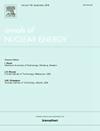Inversion of nuclear accident source terms combining Bayesian method with machine learning
IF 1.9
3区 工程技术
Q1 NUCLEAR SCIENCE & TECHNOLOGY
引用次数: 0
Abstract
Source term inversion plays a critical role in consequence assessment during nuclear accidents. This study investigates three Bayesian approaches for machine learning-based source term inversion, with datasets generated by the radioactive nuclide atmospheric dispersion program RADC. Firstly, a Bayesian neural network (BNN) was designed using Python to predict the release rate of I-131 during nuclear accidents. The BNN achieved a mean absolute percentage error (MAPE) of 7.92%, showing significantly higher accuracy and robustness compared to a backpropagation neural network (BPNN) with an identical structure and under the same accident scenarios. Secondly, both BNN and BPNN are further enhanced through Bayesian optimization, achieving a significantly improved MAPE values of 5.78% and 3.80% respectively. Furthermore, The Monte Carlo Dropout method was used to generate confidence intervals for the BPNN, offering an uncertainty analysis approach for conventional neural networks in source term inversion. However, its uncertainty analysis showed greater fluctuations compared to BNN.
求助全文
约1分钟内获得全文
求助全文
来源期刊

Annals of Nuclear Energy
工程技术-核科学技术
CiteScore
4.30
自引率
21.10%
发文量
632
审稿时长
7.3 months
期刊介绍:
Annals of Nuclear Energy provides an international medium for the communication of original research, ideas and developments in all areas of the field of nuclear energy science and technology. Its scope embraces nuclear fuel reserves, fuel cycles and cost, materials, processing, system and component technology (fission only), design and optimization, direct conversion of nuclear energy sources, environmental control, reactor physics, heat transfer and fluid dynamics, structural analysis, fuel management, future developments, nuclear fuel and safety, nuclear aerosol, neutron physics, computer technology (both software and hardware), risk assessment, radioactive waste disposal and reactor thermal hydraulics. Papers submitted to Annals need to demonstrate a clear link to nuclear power generation/nuclear engineering. Papers which deal with pure nuclear physics, pure health physics, imaging, or attenuation and shielding properties of concretes and various geological materials are not within the scope of the journal. Also, papers that deal with policy or economics are not within the scope of the journal.
 求助内容:
求助内容: 应助结果提醒方式:
应助结果提醒方式:


